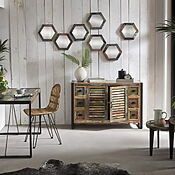At a time when we live, work and relax more than ever in our own four walls, the design of our living space increases in importance.
Wall decoration plays a major role - and poster art has developed into a modern means of current living space design.
The development of poster art: from the advertising medium check artwork
Originally designed as an advertising medium, posters have developed into independent works of art over the decades. What was once considered a temporary medium has established itself as an integral part of the living space design.
The developments around the 'affiche' in France of the early 20th century reveal the change from simple advertising to an estimated art form. While the English term 'poster' bears a utilitarian connotation, 'affiche' in French implies deeper artistic importance.
This becomes particularly clear in the works of Alphonse Mucha and Henri de Toulouse-Lautrec .

Alphonse Mucha advertising poster
The history of the 'affiche' is closely linked to the consumer culture of the late 19th century. Pioneering department stores like Le Bon Marché in Paris and Macy’s in New York recognized the potential of the artistic poster in order to visually address the emerging middle class and thus to renew their sales strategies. Artistically designed posters were not used to announce products and special campaigns and transformed urban spaces into living canvases.

Image source: JL Filpoc, CC BY-SA 4.0, via Wikimedia Commons
In addition to retail goods, the developing entertainment industry also played a central role. The Moulin Rouge, for example, used iconic 'affiches' by Henri de Toulouse-Lautrec to make its performers known, while the cinema created poster that became popular art objects.
Furthermore, transport companies contributed to the distribution by having impressive posters designing that promoted travel romanticized and exotic destinations. Thus, they established poster art as an important cultural phenomenon.
Posters are now an expression of personality, taste and lifestyle. The variety in variations is almost limitless. From classic art prints to modern photographs, from abstract compositions to detailed illustrations - this selection of poster now includes almost every conceivable style and every conceivable topic.
This variety helps us to find the right addition to our respective furnishing style.
About the psychological effect of Wall Art
Studies show that the visual environment has a significant impact on our well -being. Colors, motifs and compositions can influence our mood, productivity and even our sleep quality.
Poster art offers an easy way to target the living atmosphere. So we can promote relaxation with calming natural motifs in the bedroom and stimulate creativity with lively, colorful, colorful designs in the work area.
This psychological component generally wall art
Trend goes to individuality
In times of mass production and standardized furnishing solutions, the need for individuality blooms.
In contrast to permanently installed elements or expensive works of art, posters are inexpensive, available in Schierer diversity, quickly placed and easily interchangeable. Convincing advantages, especially for design -conscious tenants.
I see a clear trend towards individualization, "
explains the Norwegian interior designer Maria Bergmann about her Instagram channel @interior.maria .
Customers want spaces that reflect their personality, and high-quality poster art is a perfect medium for this – affordable, versatile, and expressive.”
See this post on Instagram
Practical tips for selection of poster and placement
Various factors play a role in choosing posters for your own living space:
- Space size and proportions: In small rooms, large -format posters with depth effect can optically enlarge the space. In large rooms, on the other hand, several smaller posters can be arranged as a group.
- Color concept: Poster should either correspond harmoniously with the existing color scheme or used as conscious contrast.
- Thematic coherence: Especially in rooms with several posters, a connecting element - be it style, color or topic - should ensure cohesion.
- Frame: The choice of the right frame can significantly influence the effect of a poster. Minimalist frames underline modern designs, while classic frames emphasize traditional motifs.
Current trends in poster art
Poster art continues to develop and reacts to broader trends in design and society. The current currents include:
- Minimalism : Reduced designs with clear lines and limited color palette
- Botanical motifs : plant illustrations and natural motifs as an expression of an increased environmental awareness
- Abstract art : free shapes and color compositions that leave space for interpretation
- Vintage aesthetics : New interpretations of classic designs with nostalgic charm
- Typography : expressive font designs as an independent graphic elements
Case study: a room, three looks
In order to demonstrate the transformative power of poster art, we carried out an experiment: a neutral living room was equipped with three different poster concepts with the help of a generative picture AI.



The results were an eye-opening, as the one says in the Anglo-Saxon so beautifully. Although furniture and wall paint remained unchanged, the change of the poster was created every time a completely different feeling of space.
A few words about quality and sustainability
High quality prints on environmentally friendly paper keep longer.
Today, professional service providers use FSC-certified materials and images that are created without the use of dangerous chemicals.
In the long term, it is worthwhile with regard to the appearance and the environmental impact to plan a little more budget for high -quality printing.

Owner and Managing Director of Kunstplaza. Journalist, editor, and passionate blogger in the field of art, design, and creativity since 2011. Successful completion of a degree in web design as part of a university study (2008). Further development of creativity techniques through courses in free drawing, expressive painting, and theatre/acting. Profound knowledge of the art market through years of journalistic research and numerous collaborations with actors/institutions from art and culture.

















